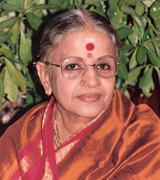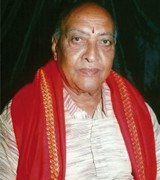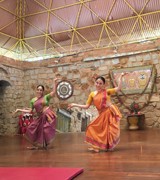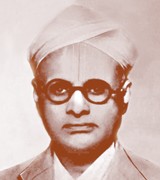COVER STORY
THE MS CENTURY - Fresh insights into the MS magic
V. RAMNARAYAN

It was said of Madurai Mani Iyer’s music that it pleased not just the connoisseur, but even the man on the street. There’s this charming story of a rickshaw puller outside Rasika Ranjani Sabha, Mylapore, who asked a customer to wait while he listened to his Eppo varuvaro or his English note. Perhaps, the only other Carnatic musicians with such a mass following have been those who first made their name as film singers.
M.S. Subbulakshmi had a similar impact on lay listeners when her songs in the film Meera took the country by
storm. Audiences in the north equated her with the Rajasthani mystic herself, with hundreds of devotees falling at her feet during the shooting of the film on the streets of Rajasthan. Songs like Katrinile varum geetam (in Tamil Meera) and, decades later, Kurai onrum illai, have also captured the imagination of millions of fans, affirming the power of emotion and language in making music accessible to common folk. (In the MS music lay a huge opportunity to take Carnatic music beyond the confines of elitist audiences, but we have made no effort to bring the fans of her songs into the folds of hard core Carnatic music rasikas). On the contrary, her immense popularity only gave critics the licence to dub her music as populist, lacking in the technical sophistication of so-called musicians’ musicians, though genuine, unbiased followers of Carnatic music know otherwise.
SPECIAL FEATURE
VEDANTAM SATYANARAYANA SARMA - Kuchipudi’s original Satyabhama
VEEJAY SAI

Vedantam Satyanarayana Sarma was born on 9 September 1935, to Subbamma and Vedantam Venkataratnam, who belonged to a traditional Kuchipudi family. By that time, Kuchipudi dance had barely crossed the borders of the Telugu speaking regions. The life story of Satyanarayana Sarma tracks the modern history of Kuchipudi.
He was only a year old when his father passed away and he came under the care of his older brother Vedantam Prahlada Sarma who taught him dance as per the family tradition. He also took training from Vedantam Lakshminarayana Sastri and Chinta Krishnamurthy. Like all the boys of his caste in his village, little Satyam was taught Sanskrit and yoga. The dance-drama format of Kuchipudi, also called Kuchipudi Yakshaganam or Bhagavata Melam, had young boys play the female roles in mythological stories. It is interesting to note that when Satyam was about to make his debut on stage, the Melam stopped him, as he was not trained in music.
SPOTLIGHT
Nrityagram, dance Utopia
Renuka Vaidyanathan

In April 2016, I met the Nrityagram dancers Surupa Sen and Bijayini Satpathy, along with Lynne Fernandez who manages the place, for the first time, although I had seen them perform in the past. They were in Singapore to perform at the SIFAS festival, which I help put together. In Songs of Love and Longing, performed at the Esplanade Theatre studio, the two dancers brought to life the 12th century love treatise Geeta Govinda. They explored the ecstatic joy as well as the anguish and despondency of the Radha-Krishna story. After watching the show and interacting with the trio, I was enthused about visiting Nrityagram, a place I have been wanting to see for many years. Less than four months later, I had the opportunity to be at Nrityagram, their absolutely idyllic dance village, which is all that it is portrayed to be and more.
INSTITUTION
SRI RAMA LALITHA KALA MANDIRA
Rajashree Yogananda

Sri Rama Lalitha Kala Mandira (SRLKM) was the vision of its founder, the late G. Vedantha Iyengar. He was born in 1898 into a family of musicians and his father, Venkatavarada Iyengar was an accomplished violinist.
Vedantha Iyengar was a multifaceted personality. A well respected teacher and erudite scholar, he was known for his zeal for social work. He built a general hospital and a maternity and child welfare centre, set up an orphanage in Holalkere, a veterinary hospital, and was involved in the renovation and restoration of ancient temples in Saligrama in Mysore district. All this was done in the late 1930s and 40s when mobilising funds was a difficult task and very little infrastructure was available. Vedantha Iyengar was conferred the “Public Service Medal” by Sri Jayachamarajendra Wodeyar, the Maharaja of Mysore, during the 1949 Dasara Durbar Celebrations in Mysore. This medal has a pride of place at the Mandira.


